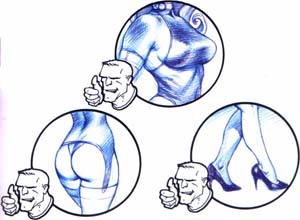While I agree with him that it’s not fair that women are expected to remove all of that hair while men are not expected to. Whatever way you look at it, is unnecessary and well just not fair. Why is it gross on a woman but not a man? While I understand this inequality, I am so socially conditioned that I can’t break through with leaving hair because I hate the idea of someone thinking of me as ‘gross’ and well I have heard those terms too often in response to female underarm or leg hair. Don’t get me wrong when I see other women with underarm hair or whatever I am not grossed out instead I want to say ‘good on you’. I just can’t seem to do it myself.
[From Me=Bad by kristy]
I’ve been on-again/off-again with things like shaving and bra-wearing. For the shaving, I faced intense pressure from some members of my family, mainly my father (who, of course, does not shave anything but his beard), and was called “gross” the few times I went out with hairy legs until I actually had it out with him and told him that he was not allowed to say that shit to me. He still does sometimes make niggling remarks, though the more I point out that those kinds of remarks are exactly why he and I aren’t close, the more he at least seems to try to stop.
I haven’t shaved for almost a year now. The last time was in summer because I got annoyed at my hair. Although I actually stopped shaving my pits completely in the summer because I kept getting painful ingrown hairs. I do trim them occasionally, because I don’t like the way it feels if it’s really long and I’m sweaty.
For anyone who wants to try to stop shaving, I would suggest starting off slow. For about two years I would shave in summer (where people could see my hair from my short sleeves and occasional skirts) but leave it long in winter, where the only one who was looking at it was my boyfriend at the time. And, well, I knew he didn’t care and furthermore if he did, I wouldn’t have been with him.
The hardest thing for me was taking the step from secretly growing my hair to publicly doing so. Like kristy, I was terrified of being seen and called “gross” — after all, hadn’t I heard that same rhetoric from my father? Hadn’t I heard my friends and family say the same things about other women who didn’t conform properly to the beauty standard? Hadn’t I, myself, once both said and believed the same things?
I was terrified. I was defensive about it. But I did it. I made my point. Right there in Miami, one of the most image-conscious cities in the USA, I put on my short skirt — in the full heat of summer, I was not going to stick to jeans, let me tell you! — leaving my legs in all their hairy glory for all to see, and marched right out of my house.
I had to go to the supermarket. I was with my best friend at the time and, believe me, I was paranoid. “Everybody’s staring at me! They’re judging me! I know what they’re saying, ‘Gawd, look at her. Doesn’t she care enough about herself to try and look good?’ I just want to die!”
But, then, because my feminism had given me the vocabulary to deal with and understand my situation, I told that part of me, “Why is it that going out as your natural self makes you want to die of embarrassment? Why is it that being proud of what you look like by nature must mean that you aren’t taking proper care of yourself? Men are allowed to grow any part of their hair that they please without these comments. That’s holding women to an unfair beauty standard. That’s inequality in action, and it’s your duty to fight it. This is why you’re a feminist. Because women aren’t allowed to feel comfortable with ourselves just the way we are.”
And so the next day, without shaving, I put on another short skirt. And the next day. And the next. I had to have it out with my father a couple of times. I was defensive to my friends and family if they asked about it. But I did it. Every day it got a little bit easier, I got a little bit less defensive, and my family started to accept it as just another quirk from the one in the family who has always marched to her own drummer.
Is there any day where I slap on my skirt in my hairy-legged glory that I don’t feel any anxiety, or any shame? No. I will most likely live and die with those feelings, thanks to the way we are socialized from young girls to feel that our natural bodies aren’t good enough. But I can’t let shame or fear run my life. I won’t let it.
So, World? My name is Andrea. I do not shave or wear makeup on a regular basis. And, you know what? I am a strong, beautiful woman who is perfect just the way she is.
 Last time I talked about two
Last time I talked about two  The beauty myth, a term coined by Naomi Wolf in her book of the same name, essentially describes the idea that a woman is viewed first by her sexuality/attractiveness and second by everything else (more information
The beauty myth, a term coined by Naomi Wolf in her book of the same name, essentially describes the idea that a woman is viewed first by her sexuality/attractiveness and second by everything else (more information 
